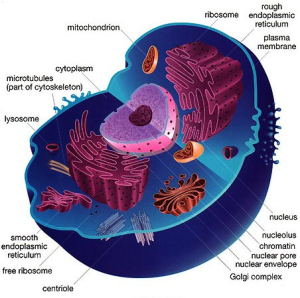Ashutosh Agrawal, assistant professor of mechanical engineering, said he likes to tell his students at the Cullen College that many lessons on mechanics and structures can be gleaned from nature. “There is so much diversity and beauty in nature, and biological cells are a wonderful example of this,” he said.
Agrawal was recently awarded $382,000 over three-years from the National Science Foundation (NSF) to study the underlying mechanics of the outer membranes of the nucleus that encapsulate the DNA of the cell.
“The same physical laws that govern the mechanics and design of skyscrapers and bridges also govern the structure and the physical response of biological cells,” Agrawal said. Nature is full of structures where functionality and beauty have been balanced in a remarkable way. The interface of a nucleus in a cell, called a nuclear envelope, is an excellent example. One can think of it as a structure made up of thousands of tiny donut-shaped pores fused together. Inside of these pores are proteins that act as gatekeepers to the vital genetic information stored inside of the nucleus. It is one of the most fascinating structures inside of biological cells, but very little is understood about the nuclear envelope.
“If we can understand the structure and the adaptation of the nuclear envelope, we can gain insight into the organization of the genetic material inside of the nucleus,” Agrawal said. The nuclear envelope can regulate gene expression by allowing proteins to access the DNA inside of the nucleus through the envelope’s pores. By examining the proteins that regulate the structure of the nuclear envelope, researchers will have a much better understanding of many diseases that are linked to mutations in these proteins. Ultimately, this work would lead to more targeted treatments or even cures for diseases linked to the cell nucleus, he added.
Researchers have yet to understand how pores in these membranes are formed to allow the passage of proteins into the nucleus. “Cells create new pores throughout their lifecycle,” Agrawal said. “This involves continuous remodeling of the nuclear membranes at the site of pore formation without disturbing the envelope away from the site. Understanding the mechanics of membrane remodeling is very relevant because if there’s a defect of any kind, the process of creating new pores will stop.”
To answer these questions, Agrawal and his team will develop models to look at the structure of the nuclear envelope and what it would take to fuse the two membranes within it together. “The models we develop will be able to predict how much energy is needed to bend the membranes, the energetics of pore formation from the two bilayers, and which proteins are up to the task of assisting in the formation of pores,” he said.
Once Agrawal's team completes these models, they will share them with collaborators at the University of Florida led by Tanmay Lele, professor of chemical and biomedical engineering. Lele’s experiments will involve making changes to the cell environment and then quantifying how those changes affect the cell structure and function. For instance, proteins will be systematically removed from the nuclear envelope and the subsequent changes in envelope structure and pore formation will be recorded.
Agrawal said this research could eventually lead to improved drug delivery using biomimetic drugs. “A multilayered structure already exists within cells, so if we can understand them, we can design sophisticated multifunctional drug delivery platforms," he said.
